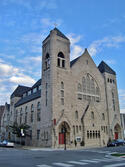Here’s part 5, the last entry of my “Tottering Chicago?” series. In case you didn’t know or had forgotten, this series was prompted after reading William Voegeli’s That Tottering Town read more »
Chicago
The "Tottering Chicago?" Series – Part 5
- Login to post comments
The "Tottering Chicago?" Series – Part 4
Here’s part 4 in the “Tottering Chicago?” series. Today I’m discussing the third question I raised after reading William Voegeli’s That Tottering Town read more »
- Login to post comments
The "Tottering Chicago?" Series – Part 3
Here’s part 3 in the “Tottering Chicago?” series. Today I’m discussing the third question I raised after reading William Voegeli’s That Tottering Town, a review of the book What Next, Chicago? read more »
- Login to post comments
The "Tottering Chicago?" Series - Part 2
Here’s part 2 in the “Tottering Chicago?” series. We’re moving on to the second question I raised after reading William Voegeli’s That Tottering Town read more »
- Login to post comments
The "Tottering Chicago?" Series - Part 1
Let me clearly state this up front. I’m doing something you won’t see very often. I’m writing a review of a book review. And providing an opinion of a book I haven’t read. Given what I’ve read in the review, I do not plan to read the book. read more »
- Login to post comments
Chicago's Density in 2020
I was playing around with Chicago population figures by community area (the 77 officially designated "communities" established in the 1920s) and ended up with a map you might find interesting. Check it out: read more »
- Login to post comments
Americans Do Not Want to Return to Urban Living
The Census Bureau recently released data on domestic migration that took place during the COVID-19 pandemic, and their findings were heavily covered in the press with headlines such as “Cities Lost Population in 2021” and “The pandemic city exodus revealed: New York, Los Angeles, San Francisco and Chicago lost the most residents.” read more »
- Login to post comments
Why the 'Old North' States Have Been Economic Laggards
My latest column is now online at Governing. It is a recapitulation of my analysis in my American Affairs piece on Indiana read more »
- Login to post comments
Quinn Chapel Story
Anyone who’s watched the changes in Chicago’s Near South Side community over the last 30 years can tell you, it’s undergone a complete transformation in a generation’s time. Many observers might look at the Near South Side and think it went from nothing to something over that period. Not true. It was always a community of constant change. My father was one person who anticipated the next transformation and fought valiantly for it to be more inclusive. read more »
- Login to post comments
The Poor Places That Made Our Cities Richer
My latest column is now online at Governing magazine. It’s a further discussion of Howard Husock’s book The Poor Side of Town: And Why We Need It. For those of you who weren’t able to check out the recording of our AEI book event, this piece discusses some of the key points.
Below is an excerpt from the column: read more »
- Login to post comments






















